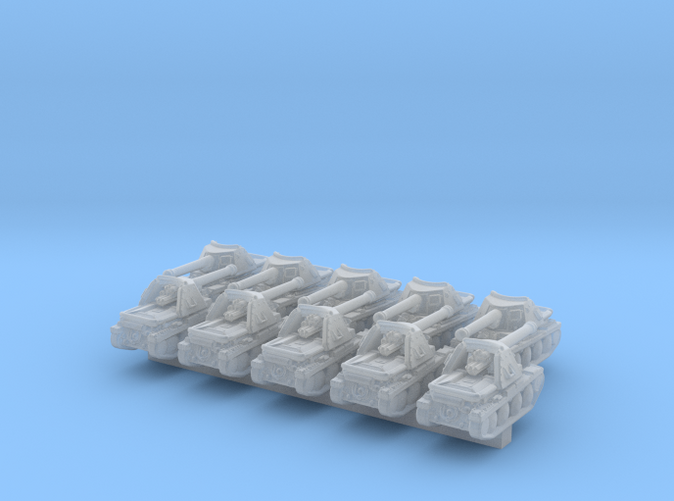1/600 Scale WW2 German Army Marder III Ausf. H Tank Destroyer.
Contains 10 highly detailed tanks.
Contains:
10x German Marder III Ausf. H Tank Destroyers
Marder III Ausf. H Tank Destroyer
Marder III was the name for a series of
World War II German tank destroyers. They mounted either Soviet
76.2 mm F-22 Model 1936 divisional field guns, or German
7.5 cm PaK 40, in an open-topped fighting compartment on top of the chassis of the
Panzer 38(t). They offered little protection to the crew, but added significant firepower compared to contemporary German tanks. They were in production from 1942 to 1944 and served on all fronts until the end of the war, along with the similar
Marder II. The German word
Marder means "
marten" in English.In the early stages of
Operation Barbarossa, the
Wehrmacht felt the need for a more mobile and more powerful anti-tank solution than the existing towed anti-tank guns, such as the
Pak 36, or self-propelled tank destroyers such as the
Panzerjäger I. This need became urgent in 1942, when anti-tank shells fired from said anti-tank guns failed to penetrate the armor of new Soviet tanks such as the
T-34 and
KV-1.
As an interim solution, it was decided to use captured French vehicles, such as the
Lorraine (
Marder I), obsolete tanks in surplus, such as the German
Panzer II (
Marder II), and Czech-supplied
Panzer 38(t) (
Marder III) as the base for the production of makeshift tank destroyers. The result was the
Marder series, which were armed with either captured Soviet
76.2mm F-22 Model 1936 divisional field guns, or German
7.5 cm PaK 40 anti-tank guns mounted in later versions. Due to weight, space and time constraints, the
Marder series had relatively thin armor when compared to other armored velicles of the era. This thin upper armor formed a gunshield, only protecting the crew from shrapnel and small arms fire on the front and sides. All
Marder series had open tops although some were issued with canvas tops to protect the crew from the elements. In this regard, the Marder was more of a gun carriage than a proper Panzerjäger that could exchange fire with enemy tanks.
The Ausf. H variant of the
Marder III fielded the standard 7.5 cm Pak 40 German anti-tank gun on a slightly modified Panzer 38(t) Ausf. H chassis. This chassis still had the engine in the rear of the vehicle but, unlike the previous model, this vehicle utilized the fighting compartment of the Panzer 38 in the center. This allowed the crew to stay low in the center of the vehicle, lowering their exposure to small arms fire and shell fragments. But, because of the rear-mounted engine, there was only enough room for two men to stand in the center. Large side armor gave additional protection for the crew. However, the thin horseshoe shaped armor only protected the front and sides; the rear and the top were exposed. Thirty-eight rounds of ammunition for the gun were carried. As with the Sd.Kfz.139, this vehicle also carried a Czech manufactured 7.92 mm machine gun in the hull.
The full name of the Ausf. H was the
7.5 cm PaK 40/3 auf Panzerkampfwagen 38(t) Ausf. H, Sd.Kfz. 138. A total of 275 vehicles were built in two series from November 1942 to April 1943. An additional 175 vehicles were converted from Panzer 38(t)'s in 1943. Chassis numbers of new vehicles were 1751–2075 and 2121–2147 (overlapping with simultaneous
Grille production).
Cleaning Information
Some part cleanup will be necessary. The 3D printing process uses a waxy substance to support certain part features during the printing process. Although the parts are cleaned by Shapeways, some waxy residue may remain. It can be safely removed with water and a mild aqueous detergent like "Simple Green" using an old, soft toothbrush, Q-tips or pipe cleaners. During the printing process, liquid resin is cured by ultraviolet light. Microscopic bits of resin may remain uncured.
Let your parts sit in direct sunlight for a few hours to fully cure the resin.
Water-based acrylic paints meant for plastics is strongly recommended. Other paints, especially enamels, may not cure on Frosted Detail 3D-printed plastics.
Use dedicated model sprue cutters to remove parts to minimise the risk of damage to parts.
Please take a look at my other items.
Painting tips and preparation
